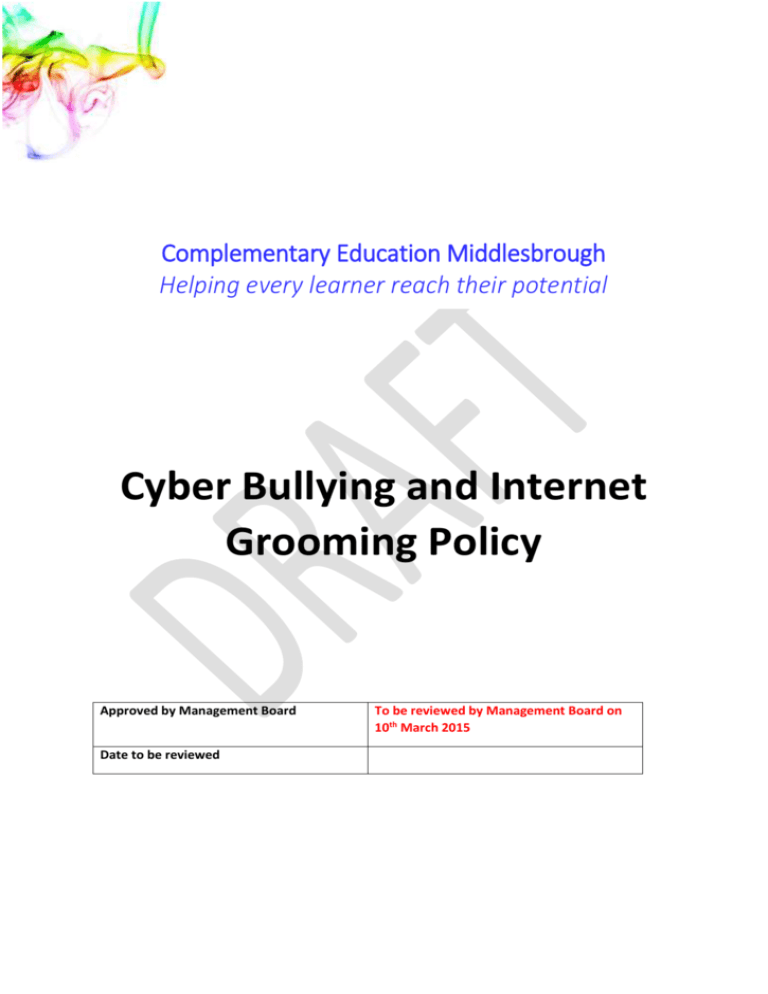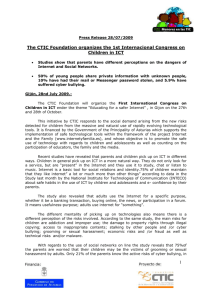Cyber Bullying and Internet Grooming Policy
advertisement

Complementary Education Middlesbrough Helping every learner reach their potential Cyber Bullying and Internet Grooming Policy Approved by Management Board Date to be reviewed To be reviewed by Management Board on 10th March 2015 Aims of the Policy This Policy outlines Complementary Education Middlesbrough’s commitment to identifying young people at risk of cyber bullying and internet grooming and the procedures staff must follow to raise concerns to the appropriate multi agency departments. Outcome: Children feel safe and are safe. Children understand how to protect themselves; and feel protected and are protected from significant harm including neglect, abuse and accident. Safeguarding and promoting the welfare of children, including keeping children safe from cyber bullying and internet grooming, is a key part of the Government’s drive to improve outcomes for children and young people. Working Together to Safeguard Children, the core Government guidance which sets out how organisations and individuals should work together to safeguard and promote the welfare of children, was published in April 2006. Healthy lives, brighter futures, the strategy for children and young people’s health, published in February 2009, sets out the Government’s long-term strategy to support children’s and families’ health including a commitment to action to ensure that all organisations with responsibility for child health and wellbeing are fulfilling their statutory responsibilities for safeguarding children. Policy Complementary Education Middlesbrough encourages young people to understand and appreciate the importance of communicating with others, including those from outside of the school, and forming active and stable relationships in their lives. Technology plays an important and developing role in this objective and common tools such as PC’s, laptops, mobile phones and tablets, for example, all harness the Internet and allow fast and instant communication. The school recognises, however, that although much of the Internet is a force for good, there are those within society who will use it for cruel and evil purposes. Cyber bullying and Internet grooming are two of the most prominent examples of such abuse. Children and young are vulnerable to such abuse, and need to be safeguarded. This policy statement aims to explain the issues in greater detail, to provide advice and guidance on how young people may be protected from significant harm and/or distress, and what action needs to be taken if abuse occurs, or is thought to be occurring. Page 2 of 8 Cyber bullying What it is cyber bullying? Cyber bullying can be defined as an aggressive, intentional act carried out by a group or individual, using electronic forms of contact, repeatedly and over time against a victim who cannot easily defend him or herself. Cyber bullying can take many forms, usually: • • • • • • • Text or voice message bullying; Picture/ Video clip bullying (via mobile phone cameras); Phone call bullying (via mobile phones); Email bullying; Chat-room bullying; Bullying through instant messaging; Bullying via websites. How can you tell if it might be happening to a young person? As cyber bullying can be extremely stressful and humiliating, victims will often be very reluctant to say that it is happening, for various reasons, including the possibility that matters may, as a result of getting things out into the open, actually get worse. Staff and parents should always be vigilant, and may see signs that a young person is being bullied such as they: • • • • • Unexpectedly stops using the computer; Appears nervous or jumpy when an IM (Instant Message), text message or email appears; Appears uneasy, unusually quiet or withdrawn. Is unwilling to go outside, or to school, for example; Appears to be angry, frustrated or upset after using the computer, a tablet or a mobile phone for example; Avoids discussions about what they are doing on the computer. If a staff member becomes aware of signs such as these, talk to the young person, or report it to the Head Teacher or a member of the Senior Leadership Team. How can you tell if a young person might be cyber bullying others? He / She – • • • Quickly switches screens or closes programs when you walk by; Uses the computer at all hours of the night; Gets unusually upset if he/she cannot use the computer; Page 3 of 8 • • • Laughs excessively while using the computer; Avoids discussions about what they are doing on the computer; Uses multiple online accounts or using an account that is not their own. If a staff member sees signs such as these, talk to the young person, or report it to the Head Teacher or a member of the Senior Leadership Team. How can we minimise the potential problems for our young people? The best way to deal with cyber bullying is to prevent it happening in the first place. How can we deal with cyber bullying when it occurs? Advice for the victim – • • • • • • • • • Talk to someone you trust about it, like a friend, a teacher or an older relative; Keep and save any bullying emails, text messages or images you receive; Make a note of the time and date that messages or images were sent, along with any details you have about the sender; Try changing your online user ID or nickname; Change your mobile phone number and only give it out to close friends; Mobile phone companies and internet service providers can trace bullies, so don’t be afraid of reporting it to them; Block instant messages from certain people or use mail filters to block emails from specific email addresses; Don't reply to bullying or threatening text messages or emails – this could make matters worse and lets those carrying out the bullying know that they've found a 'live' phone number or email address; Report serious bullying, like threats of a physical or sexual nature, to the police. What can staff do? Always be alert to the possibility that one or more of the children in you care are being bullied, or, quite possibly, are bullies themselves. It is reported that 1 in 5 schoolchildren have, at some time, been the victim of online and mobile abuse. Be supportive. If you sense something is wrong, then talk to the child/young person to find out what the real problem is. Report the bullying to the appropriate person/organisation. All of the most important ISP’s, Social Network Sites, Mobile Phone companies etc. have facilities for dealing with cyber bullying, including dedicated websites. Talk to them about the problem, listen to their advice and gain their support. Page 4 of 8 Internet Grooming What it is Internet Grooming? Essentially, Internet grooming is: The process by which a person befriends a child to gain his or her trust and to create a situation whereby the child will allow the perpetrator to have sexual contact with him or her and will not tell anyone of it. Such activity is criminal, and an offence under s.15 of the Sexual Offences Act 2003. A new report by the cyberspace research unit at the University of Central Lancashire has set out the “'grooming process” used by paedophiles to befriend children over the internet with the intention of abusing them, as follows: 1. Friendship Flattering a child into talking in a private chat room where they will be isolated. The child will often be asked for a non-sexual picture of themselves. 2. Forming a relationship Asking the child what problems they have to create the illusion of being their best friend. 3. Risk assessment Asking the child about the location of their computer and who else has access to it in order to assess the risk of being detected. 4. Exclusivity Building up a sense of mutual love and trust with the child, suggesting that they can discuss "anything" 5. Sex talk Engaging the child in explicit conversations and requesting sexually explicit pictures from them. At this stage the paedophile will usually try to arrange a meeting with the child. Page 5 of 8 How can you tell if a young person is being “groomed”, over the Internet? This is a difficult question and often impossible to answer. Sadly, most cases of “grooming” come to light after the abuse has taken place, something which brings sharply into focus the need for education of children in what could happen and how to avoid the dangers. It is reported that predators use the following tactics, when communicating with young children: Things they might say What it really means Let's go private Let’s move to a private chat room, instant messaging or phone. Where’s the computer in your house? Helps the predator understand if the parents/carer is around. What kinds of music do you like? Movie? Hobbies? Clothes store? This is helps the groomer get to know you better and know what gifts to offer. I can help you get a modelling job They are flattering you, to get you to cooperate. You seem upset. Tell me what’s bothering you Trying to get your trust using sympathy. Where do you live? What school do you go to? What’s your phone number Asking for personal info – usually after the target is feeling comfortable. If you don’t do what I ask I’ll show your parents/carer Intimidation and threats – scare tactics to achieve the photos you’ve sent me the predator’s goal. You are the love of my life To convince target to cooperate How can we minimise the potential problems for our young people? As with cyber bullying, the school’s primary weapon against Internet grooming is education and the topic will be discussed at young person meetings at regular intervals so that children and young people in the school understand what the subject is about, that grooming doesn’t only happen to girls, what the “grooming process” is, and that children of any age can be targets. If possible, keep a check on any new online ‘friends’. It’s likely that most friends young people meet online will be innocent in their intentions, with no desire to harm, but it’s also better to be over cautious than to regret it later. Requests to meet new “online friends”, in person, and alone, will be the subject of a careful risk assessment and will generally have to be refused unless adequate controls and safeguards are introduced. Young people should be told NEVER to meet a new online friend alone, and away from the school without discussing it with staff first. Page 6 of 8 Other possible routes towards minimising the risks associated with Internet grooming include: • Install parental control software, such as, for example Puresight PC. This software (which has to be bought after a trial period of 30 days) can identify and block harmful content in chats, forums and other internet communication tools (or just alert you about them, if you so choose). Young people should be told that such software has been installed for their own safety, and not because you want to “pry”. • Place the computer in a group recreation room or somewhere visible (not in the child’s bedroom). But remember that children in your care may have other means of accessing the Internet and communicating with potential predators. So pay attention to other computer and Internet-enabled mobile devices. • Most social networking sites require that users be aged 13 and over. Make sure young people follow these age restrictions. • Limit and monitor the amount of time the children in your care spend on the Internet, and at what times of day. Too much time online, especially at night, may be a sign of a problem. • Make sure young people understand and follow these rules of thumb for chat rooms: 1. 2. 3. 4. Young children should not be allowed to use chat rooms at all; Older children should be directed to monitored chat rooms; Get to know the chat rooms your young people do visit and with whom they talk; Check to see the kind of conversations that take place. Chat rooms featuring subjects that attract children and teenagers, such as music, sports, or fashion, are prime targets of child sexual predators, who often disguise themselves as peers. • Instruct young people to never leave the chat room's public area and engage in a one-onone chat in a private area. These areas are unmonitored. • Tell young people to never respond to instant messaging or e-mails from strangers. • If young people use computers in places outside your supervision, such as a public library, school, or friends' homes, find out what computer safeguards are used. How can we deal with it if it occurs? If you do suspect a young person is being groomed report it to the site moderator or the police (or both) who can investigate. At this stage, it may only be a suspicion, so it is important that wild or inappropriate allegations are not made. Remember also that the nature of grooming does mean it can be hard to prove until explicitly sexual requests have been made. Page 7 of 8 It is not a crime for adults to chat to children in chat rooms but it is illegal to do so with the intention of sexually abusing them. Useful Websites (Control + Click to view) Anti bullying alliance Beat bullying Bullying UK Cybermentors Childline Stop cyberbullying Kidscape Direct gov Stop bullying That’s not cool Samaritans Mums net Action for children Childnet International Safe kids.com Page 8 of 8




